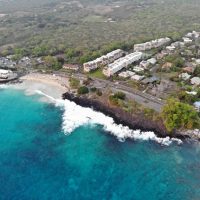Learning to fly the Mavic Air has been a pleasure, and actually much easier than I feared.

Our annual boating trip into the wilds of Alaska and British Columbia offers stunning photographic opportunities for a drone. Not that the island of Hawaii does not offer a great place to learn.
Now or never! So I put down the money and bought the aircraft.
With drone in hand I need to learn to fly it. I need practice to achieve the level of competency I feel is required. I have had a month to practice, a month I have made good use of. Regularly flying and logging quite a few discharged batteries each week.
I am taking learning to fly seriously.
To watch a thousand dollar drone disappear into the sky takes a leap of faith. Faith in the technology and faith in your own skill to pilot the drone back to the launch site. Any number of times I have piloted it far enough away that the drone itself is lost to view, even though I have a clear view of where it is. It is always reassuring to hear the buzzing grow louder and have this little aircraft reappear as it returns.
In my short time of flying it one thing is apparent… The Mavic Air is impressive, completely fulfilling my requirements. The specifications are much better than I expected in such a small aircraft. It will be some time before I can use it to its full potential.
Still, I find myself sliding sideways occasionally when I mean to rotate the drone in the air. I will take yet more practice to gain complete control in the air. Exchanging left and right hand functions seems to be my most frequent error.
There are other lessons to learn. When moving at full speed the drone takes some distance to come to a halt. That was learned at Deb’s expense, still laughing about how fast my wife can duck!
Other issues to leanr? Rotation flips perspective when you are looking at the screen versus looking at the drone directly. Much the same as a your left or my left question.

Situational awareness is also a major skill I am still learning. Where the drone is with respect to obstacles in the flight path. The Air does have built in obstacle avoidance, but the manuals and how-to videos emphasize that it is best not to rely on this tech. For now I remain quite conservative in giving obstacles a wide margin.
I have achieved a reasonable level of competency, enough I consider myself ready to begin flight operations from the Nordic Quest. Certainly I can bring the craft in to a neat stop within reach for a out-of-the-air grab recovery. A month of flying off the boat will show if my month of intensive flight practice was sufficient.
Does this plucky little drone return from an Inside Passage voyage intact?

